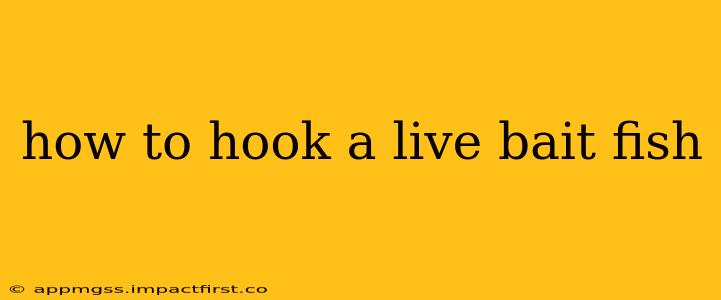How to Hook a Live Bait Fish: A Guide for Anglers
Hooking a live bait fish correctly is crucial for successful fishing. A poorly hooked bait will quickly die, struggle weakly, or fall off, resulting in missed bites and frustrated anglers. This comprehensive guide will walk you through various techniques, ensuring your bait stays lively and attractive to the target fish.
What Type of Hook Should I Use?
The choice of hook depends heavily on the size of your baitfish and the species you're targeting. Generally, you want a hook that's appropriately sized to the bait—large enough to hold securely but small enough to minimize injury and maximize the bait's swimming ability.
-
Small to Medium Baitfish (e.g., minnows, shiners): Small, light-wire hooks like a size 6 or 4 are ideal. A long shank hook allows for better penetration and prevents the hook from tearing out easily.
-
Larger Baitfish (e.g., small herring, shad): For larger bait, use a slightly heavier-gauge hook, sizes 2/0 to 4/0. These hooks need to be strong enough to withstand the pull of larger fish.
-
Hook Styles: Both circle hooks and Kahle hooks are popular choices for live bait. Circle hooks reduce the chances of gut hooking the baitfish, and Kahle hooks offer excellent hooking and holding power. However, traditional J-hooks are also commonly used and effective.
How to Hook a Live Bait Fish Without Killing It?
The goal is to hook the bait fish in a way that allows it to swim naturally, attracting predatory fish. Here's a step-by-step guide:
-
Choose Your Hooking Point: The most effective hooking point is typically the top lip or just below the dorsal fin (on the back). This location minimizes injury and allows the bait to swim normally.
-
Gentle Grip: Hold the baitfish firmly but gently. Too much pressure can injure or kill it.
-
Quick and Accurate Placement: Quickly and accurately insert the hook into your chosen point. Aim for a swift, straight insertion to minimize trauma. Avoid over-penetrating.
-
Set the Hook (Gently): Gently but firmly set the hook. Avoid jerking or yanking, which can damage the baitfish.
What Are the Best Practices for Keeping Live Bait Alive?
Keeping your baitfish alive and healthy is just as important as hooking them correctly. Here are some key tips:
- Aerated Bait Bucket: Use a well-aerated bait bucket with plenty of water to keep the oxygen levels high.
- Proper Bait Storage: Store your bait in a shaded, cool area.
- Avoid Overcrowding: Don't overcrowd your bucket.
- Maintain Water Quality: Change the water regularly to prevent waste build-up.
How Do I Keep My Live Bait From Escaping?
Escaping bait is a common problem. Here are some solutions:
- Secure Bait Bucket Lid: Ensure your bait bucket has a securely fastened lid to prevent escapes.
- Proper Bait Handling: When transferring bait, work quickly and carefully to avoid accidental releases.
- Bait Net: Keep a bait net handy for transferring fish from the container to the hook, and vice versa.
What Happens if I Hook My Baitfish in the Wrong Place?
Hooking a baitfish in the wrong place, such as in the eye or the body, will likely kill or severely injure it, rendering it ineffective as bait. A struggling, injured baitfish is much less attractive to a predatory fish.
This detailed guide should help you successfully hook your live bait and enjoy a more productive fishing trip. Remember practice makes perfect, so don’t get discouraged if it takes a few tries to master the technique. Experiment and find what works best for your specific bait and fishing conditions.
